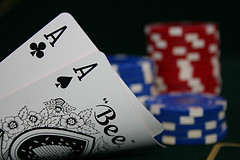 Image via WikipediaFrom what have you probably seen in television, you might have noticed some great bluffs that made many doubt if their hands are strong enough (when it truly is), then throw it away out of fear. It is a skill that serious poker players have to incorporate into their game to be successful in poker and stack up the chip count in the long run.
Image via WikipediaFrom what have you probably seen in television, you might have noticed some great bluffs that made many doubt if their hands are strong enough (when it truly is), then throw it away out of fear. It is a skill that serious poker players have to incorporate into their game to be successful in poker and stack up the chip count in the long run.There are basic bluffs that one really has to do especially in short-tables and ones that you only do sparingly that pave the way to the pot.
A Basic Bluff
Technically, this technique is a semi-bluff, but it is deceptive nonetheless. It makes your opponents believe that you have the top pair but in reality, you merely have a drawing hand. Let’s look an example:
You have J-6, both hearts, with four people in the table. The flop shows A-5-8 with the last two having hearts as suits. It’s an ugly flop for those holding face cards except ace and this is an opportunity to make a good-sized flop of around 2/3 of the pot. You seem to represent that you have a pair of eights or aces but you only have the flush draw. In the case that a suit other than a heart shows up on the turn card, don’t fold immediately to a bet. See first if you get sufficient pot odds for calling it. A good size is 3/5 or below as compared to the size of the pot. This way, not only do you have an opportunity to hit a flush, you make sure that it won’t eat up your stack substantially that it renders you soft and defenseless.
Advanced Bluffs
These kinds of bluffs usually appear in the latter stages of the betting round, done when the turn and/or the river card shows up. It may be a panicked all-in when you have the nuts or a soft-looking bet on the river that scares advanced players out their wits (I’ll explain why later).
First is the jumpy all-in bet. There is a specific sequence of circumstances that makes this bluff work. First is that you must raise pre-flop with medium to low suited connectors like 3-4 diamonds or 6-7 hearts. The raise, of course, represents something else like Queens or Jacks. When you hold 6-7 hearts and the flop shows 4-5-9, with the first two having hearts for a suit, put down the automatic continuation bet of around half the pot, showing that you have high face cards and you seem to believe that the flop didn’t hit your opponents either. Of course, they will call that bet. When 8-of-hearts is shown on the turn, then you have the nut straight flush, beating anyone who holds a straight. When this happens, don’t just shove your chips right there. Think for a long while and then go all-in. This gives off the impression that you have a set. If anyone has a straight, which is likely because he/she called a good-sized bet, he/she will call it given the seeming desperation of your bet.
The second bluff I’ll teach you is the Post-Oak Bluff. It is very simple; both are bold enough to bet until the river card shows up, when you make a smallish bet of around 1/3 of the pot. It seems as if you are begging him to call you, in an attempt to maximize your gain. But in truth you only have a weak hand, trying to outplay your opponent. This bluff only works for top players, who know the science behind poker betting.
There is an old adage that says large bets scare the beginner while small ones frighten the strong ones. Keep that in mind and you’ll have a good base for your bluffs, and you’ll win more pots in the long run.


